Typical values at TA = +25°C, ADC
Sampling Rate = 2949.12 GHz. Default conditions: output sample rate = 491.52MSPS
(decimate by 6), PLL clock mode with fREF = 491.52MHz, AIN =
–3 dBFS, DSA setting = 4 dB.
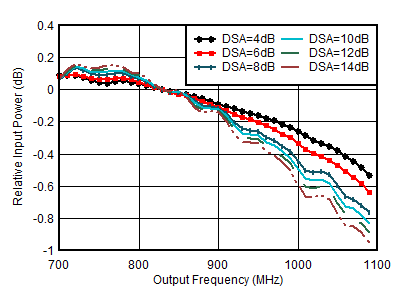
| With 0.8 GHz matching, normalized to
830 MHz |
|
Figure 7-50 RX
In-Band Gain Flatness for Channel 1RX,
fIN = 830 MHz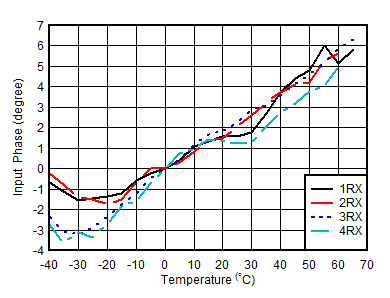
| With 0.8 GHz matching, normalized to
phase at 25°C |
|
Figure 7-52 RX
Input Phase vs Temperature and DSA at
fOUT = 0.8 GHz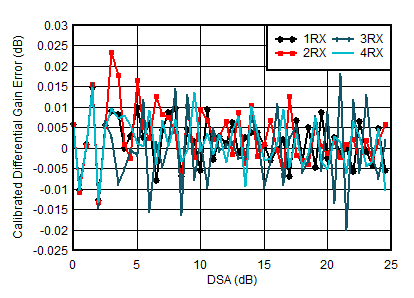
| With 0.8 GHz matching |
| Differential Amplitude Error =
PIN(DSA Setting – 1) –
PIN(DSA Setting) + 1 |
Figure 7-54 RX
Calibrated Differential Amplitude Error vs DSA
Setting at 0.8 GHz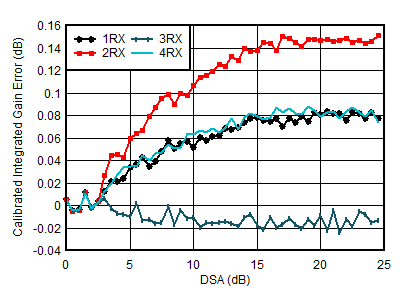
| With 0.8 GHz matching |
| Integrated Amplitude Error =
PIN(DSA Setting) – PIN(DSA
Setting = 0) + (DSA Setting) |
Figure 7-56 RX
Calibrated Integrated Amplitude Error vs DSA
Setting at 2.6 GHz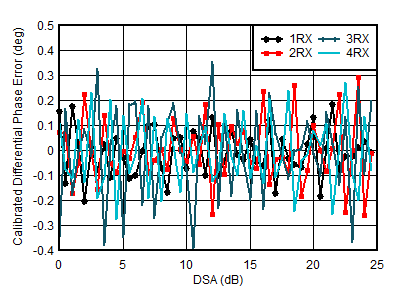
| With 0.8 GHz matching |
| Differential Phase Error =
PhaseIN(DSA Setting – 1) –
PhaseIN(DSA Setting) |
Figure 7-58 RX
Calibrated Differential Phase Error vs DSA Setting
at 0.8 GHz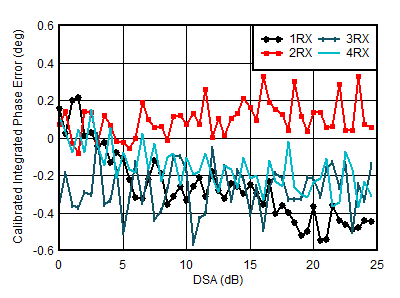
| With 0.8 GHz matching |
| Integrated Phase Error = Phase(DSA
Setting) – Phase(DSA Setting = 0) |
Figure 7-60 RX
Calibrated Integrated Phase Error vs DSA Setting
at 0.8 GHz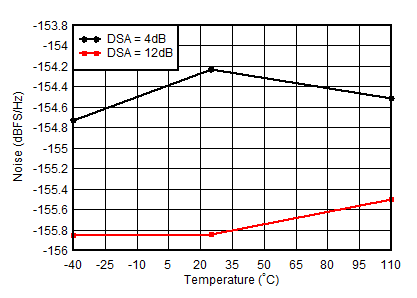
| With 0.8 GHz matching, 12.5-MHz offset
from tone |
Figure 7-62 RX
Noise Spectral Density vs Temperature at 0.8
GHz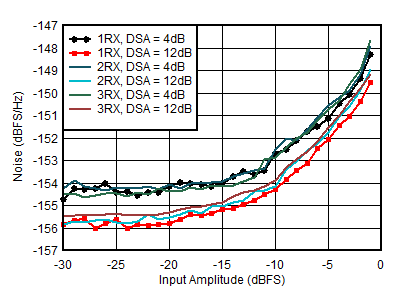
| With 0.8 GHz matching, 12.5-MHz offset
from tone |
|
Figure 7-64 RX
Noise Spectral Density vs Input Amplitude and
Channel at 0.8 GHz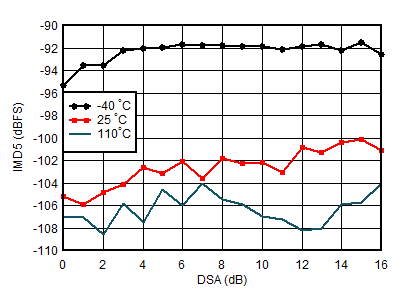
| With 0.8 GHz matching, each tone –7
dBFS, tone spacing = 20 MHz |
Figure 7-66 RX
IMD5 vs DSA Setting and Temperature at 0.8
GHz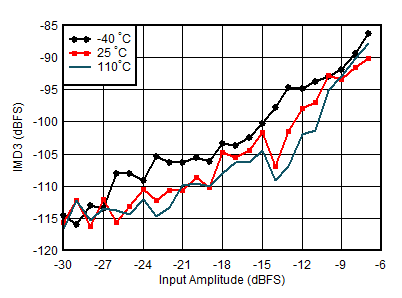
| With 0.8 GHz matching, tone spacing =
20 MHz, DSA = 12 dB |
Figure 7-68 RX
IMD3 vs Input Level and Temperature at 0.8
GHz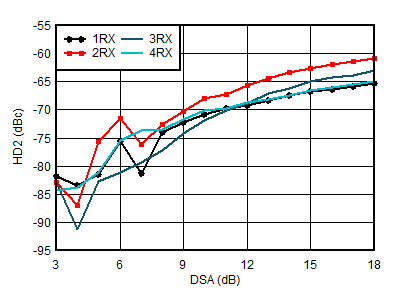
| With 0.8 GHz matching, measured after
HD2 trim, DDC bypass mode (TI only mode for
characterization) |
Figure 7-70 RX
HD2 vs DSA Setting and Channel at 0.8 GHz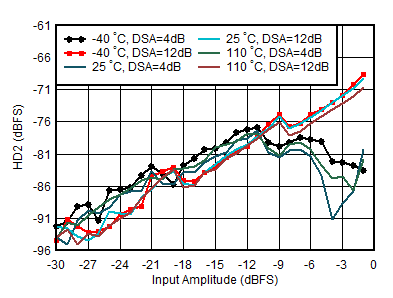
| With 0.8 GHz matching, measured after
HD2 trim, DDC bypass mode (TI only mode for
characterization) |
Figure 7-72 RX
HD2 vs Input Level and Temperature at 0.8
GHz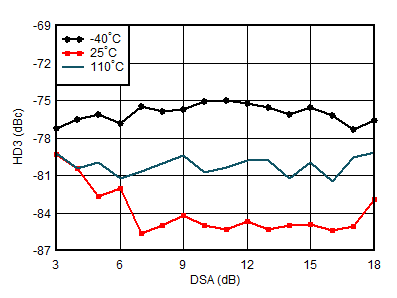
| With 0.8 GHz matching, DDC bypass mode
(TI only mode for characterization) |
Figure 7-74 RX
HD3 vs DSA Setting and Temperature at 0.8
GHz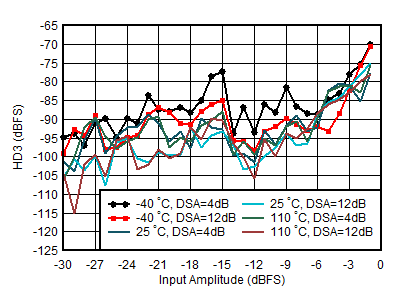
| With 0.8 GHz matching, DDC bypass mode
(TI only mode for characterization) |
Figure 7-76 RX
HD3 vs Input Level and Temperature at 0.8
GHz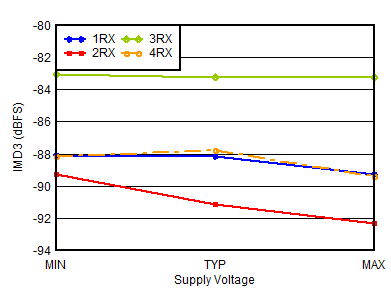
| With 0.8 GHz matching, –7 dBFS each
tone, 20-MHz tone spacing, all supplies at MIN,
TYP, or MAX recommended operating voltages |
Figure 7-78 RX
IMD3 vs Supply and Channel at 0.8 GHz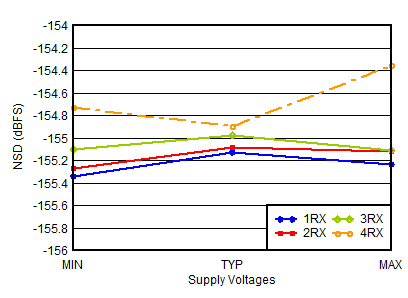
| With 0.8 GHz matching, 12.5-MHz offset,
all supplies at MIN, TYP, or MAX recommended
operating voltages |
Figure 7-80 RX
Noise Spectral Density vs Supply and Channel at
0.8 GHz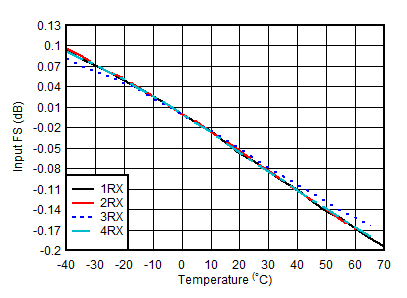
| With 0.8 GHz matching, normalized to
fullscale at 25°C for each channel |
Figure 7-51 RX
Input Fullscale vs Temperature and Channel at 800
MHz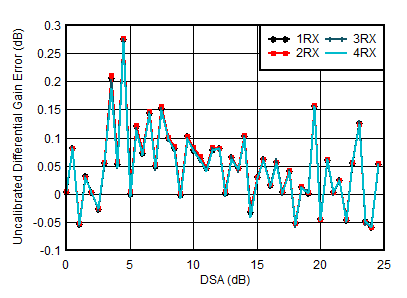
| With 0.8 GHz matching |
| Differential Amplitude Error =
PIN(DSA Setting – 1) –
PIN(DSA Setting) + 1 |
Figure 7-53 RX
Uncalibrated Differential Amplitude Error vs DSA
Setting at 0.8 GHz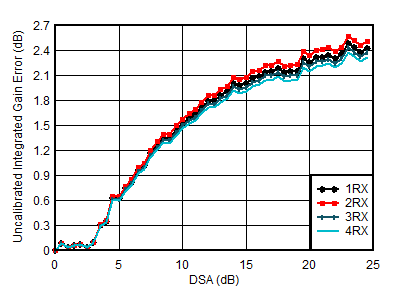
| With 0.8 GHz matching |
| Integrated Amplitude Error =
PIN(DSA Setting) – PIN(DSA
Setting = 0) + (DSA Setting) |
Figure 7-55 RX
Uncalibrated Integrated Amplitude Error vs DSA
Setting at 0.8 GHz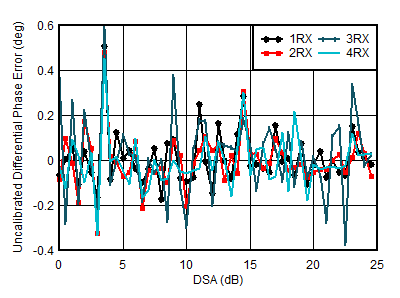
| With 0.8 GHz matching |
| Differential Phase Error =
PhaseIN(DSA Setting – 1) –
PhaseIN(DSA Setting) |
Figure 7-57 RX
Uncalibrated Differential Phase Error vs DSA
Setting at 0.8 GHz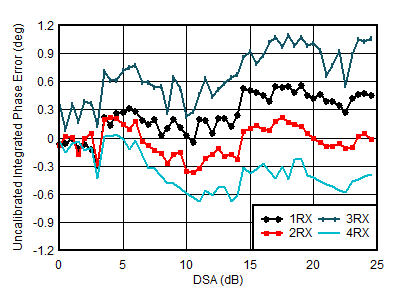
| With 0.8 GHz matching |
| Integrated Phase Error = Phase(DSA
Setting) – Phase(DSA Setting = 0) |
Figure 7-59 RX
Uncalibrated Integrated Phase Error vs DSA Setting
at 0.8 GHz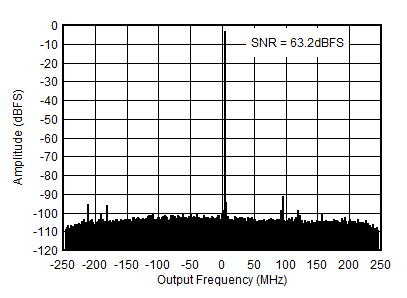
| With 0.8 GHz matching, fIN =
840 MHz, AIN= –3 dBFS |
Figure 7-61 RX
Output FFT at 0.8 GHz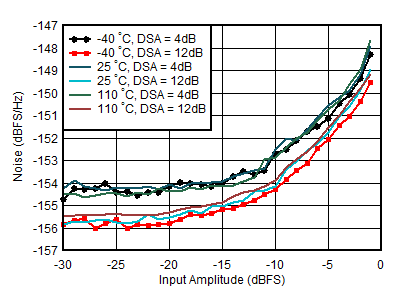
| With 0.8 GHz matching, DSA Setting = 12
dB, 12.5-MHz offset from tone |
Figure 7-63 RX
Noise Spectral Density vs Input Amplitude and
Temperature at 0.8 GHz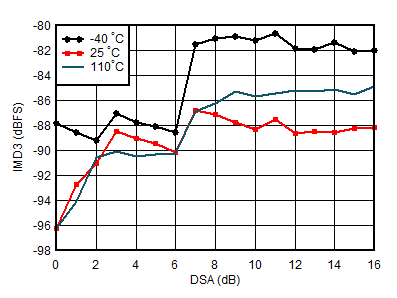
A.
| With 0.8 GHz matching, each tone –7
dBFS, tone spacing = 20 MHz |
Figure 7-65 RX
IMD3 vs DSA Setting and Temperature at 0.8
GHz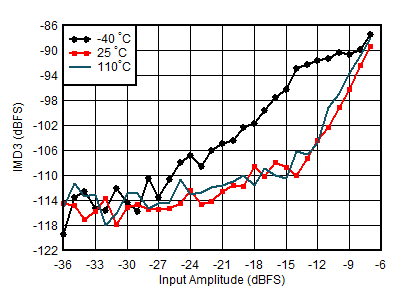
| With 0.8 GHz matching, tone spacing =
20 MHz, DSA = 4 dB |
Figure 7-67 RX
IMD3 vs Input Level and Temperature at 0.8
GHz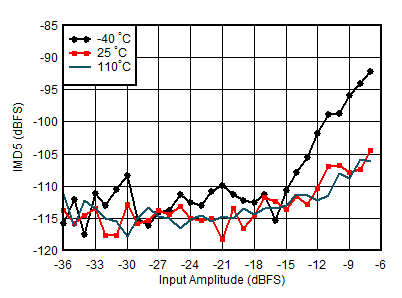
| With 0.8 GHz matching, tone spacing =
20 MHz, DSA = 12 dB |
Figure 7-69 RX
IMD5 vs Input Level and Temperature at 0.8
GHz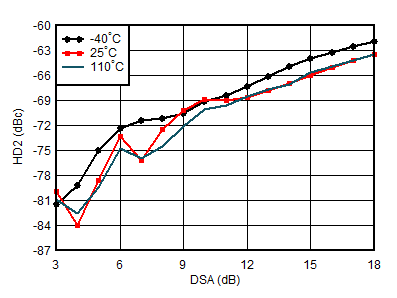
| With 0.8 GHz matching, measured after
HD2 trim, DDC bypass mode (TI only mode for
characterization) |
Figure 7-71 RX
HD2 vs DSA Setting and Temperature at 0.8
GHz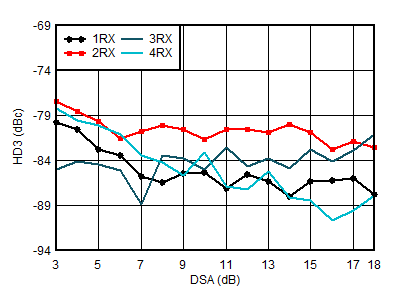
| With 0.8 GHz matching, DDC bypass mode
(TI only mode for characterization) |
Figure 7-73 RX
HD3 vs DSA Setting and Channel at 0.8 GHz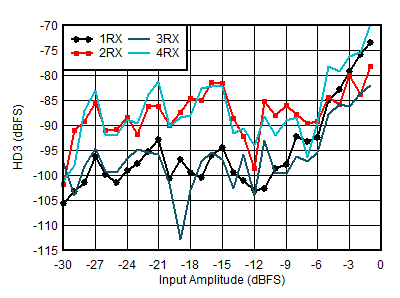
| With 0.8 GHz matching, DDC bypass mode
(TI only mode for characterization) |
Figure 7-75 RX
HD3 vs Input Level and Channel at 0.8 GHz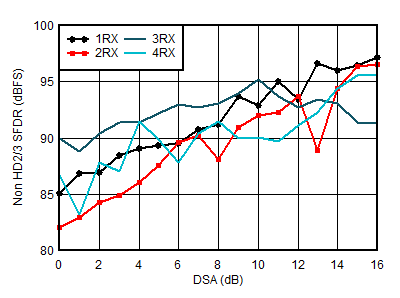 Figure 7-77 RX
Non-HD2/3 vs DSA Setting at 0.8 GHz
Figure 7-77 RX
Non-HD2/3 vs DSA Setting at 0.8 GHz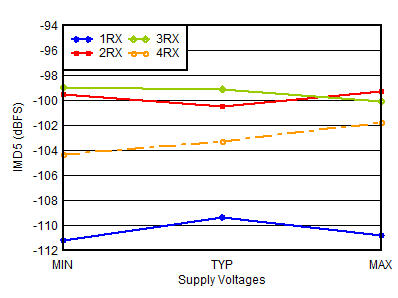
| With 0.8 GHz matching, –7 dBFS each
tone, 20-MHz tone spacing, all supplies at MIN,
TYP, or MAX recommended operating voltages |
Figure 7-79 RX
IMD5 vs Supply and Channel at 0.8 GHz





























